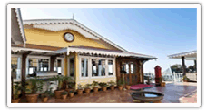|
|
|
| |
Travel destination in India, Guwahati |
| |
[ Book Hotels in Guwahati] |
[ other Travel Destinations in India ] |
| |
General Information about GUWAHATI |
Guwahati :
Area : 4,345 Sq. km.
Language : Assamese, Bengali & English.
State : Assam.
Best Time To Visit : November to April.
STD Code : 0361 |
About Guwahati
Guwahati is a city in India, often considered to be the gateway to the north-east part of the country. A Guwahati suburb, Dispur, is the capital of the Indian state of Assam. The city is between the southern bank of the Brahmaputra river and the foothills of the Shillong plateau. It is also the home to the Indian Institute of Technology, Guwahati.
The name Guwahati is derived from two Assamese words: guwa (betel nut) and hat (market place). It was situated midway between two powerful kingdoms: the Ahom and the Koch kingdoms. Later when the Koch regions were overrun by the Mughals, Guwahati would intermittently be the seat of a forward Mughal commander. Neither the Mughals nor the Koch could maintain power at Guwahati, however, and it became better known as the seat of the Borphukan, the civil and military authority of the region appointed by the Ahom king.
HOW TO REACH
By Air : The functional airports are at Guwahati, Jorhat, Silchar, Dibrugarh, and Tezpur. There are regular air services for New Delhi and Calcutta from Guwahati. Dibrugarh, Jorhat, and Tezpur are also connected to Calcutta by regular flights.
By Rail : Guwahati is the largest railway station in Assam. It is connected by rail to Delhi, Calcutta, Lucknow, Thiruvananthapuram, Mumbai, and other parts of the country. There is also a good railway network that connects every part of the state.
By Road : A good road network connects all the important places of the state with the state capital. Guwahati is 2160 km from Delhi, 3104 km from Mumbai, 2688 km from Chennai, and 595 km from Darjeeling.
PLACES OF ATTRACTION IN GUWAHATI
•Chandubi Lake : A natural lagoon and fine picnic spot which is 64 kms. from Guwahati. The lake and its surroundings is an ideal holiday resort with the added attraction of fishing and rowing.
• Sualkuchi : Assam produces three unique varieties of silks, the Golden Muga, the White Pat and the warm Eri. Silks grown all over the state find their way to Sualkuchi, 32 kms from Guwahati. Sualkuchi is one of the world's largest weaving villages often called the Manchester of the East. The entire population here is engaged in weaving exquisite silf fabrics. A renowned centre of silk production, particularly known for Muga - the golden silk of Assam which is not produced anywhere else in the world.
• Hajo : Located 32 kms. from Guwahati on the north bank of the Brahmaputra, it is a place where three religions meet - Hinduism, Islam and Buddhism.
It has a large number of temples, the chief among them being Hayagriva-Madhab Temple. There is a belief that this temple contains the relic of Lord Buddha, while a section of the Buddhist hold that Lord Buddha attained nirvana here. Large number of Bhutanese visit this temple every year during the winter season.
•Majuli : Assam is famous for Majuli, the world's largest river island. Majuli situated in the midst of river Brahmaputra, is the centre of Vishnava culture.
The total area of Majuli has been steadily decreasing due to strong erosion of the river Brahmaputra. The area of the island has reduced from 2,82,165 acres in 1853 to less than 886 sq. kms today.There are over fifteen Vaishnava monasteries or satras on Majuli. The major satras are Kamalabari, Natun Kamalabari, Auniati, Garmur, Samoguri, Dakhinpat and Bengenaati. These satras are regarded as the main centres for Assamese art, music, dance, drama, handicrafts, literature and religion etc. Auniati is famous for its considerable collection of Assamese old utensils, jewellery and handicrafts. |
|
|
|
|
|
|
|







